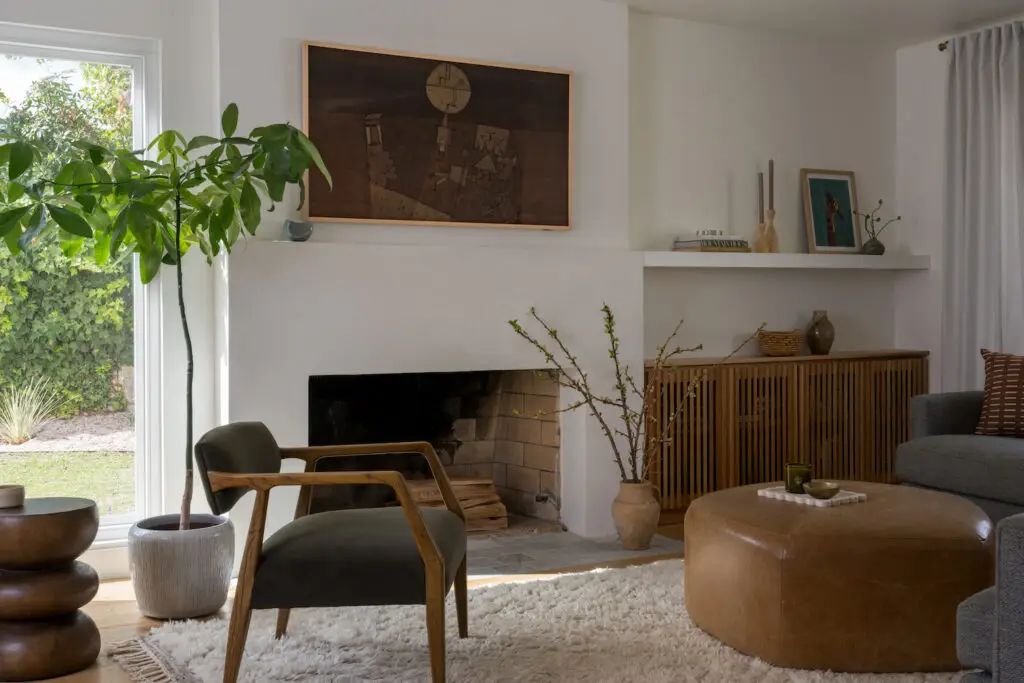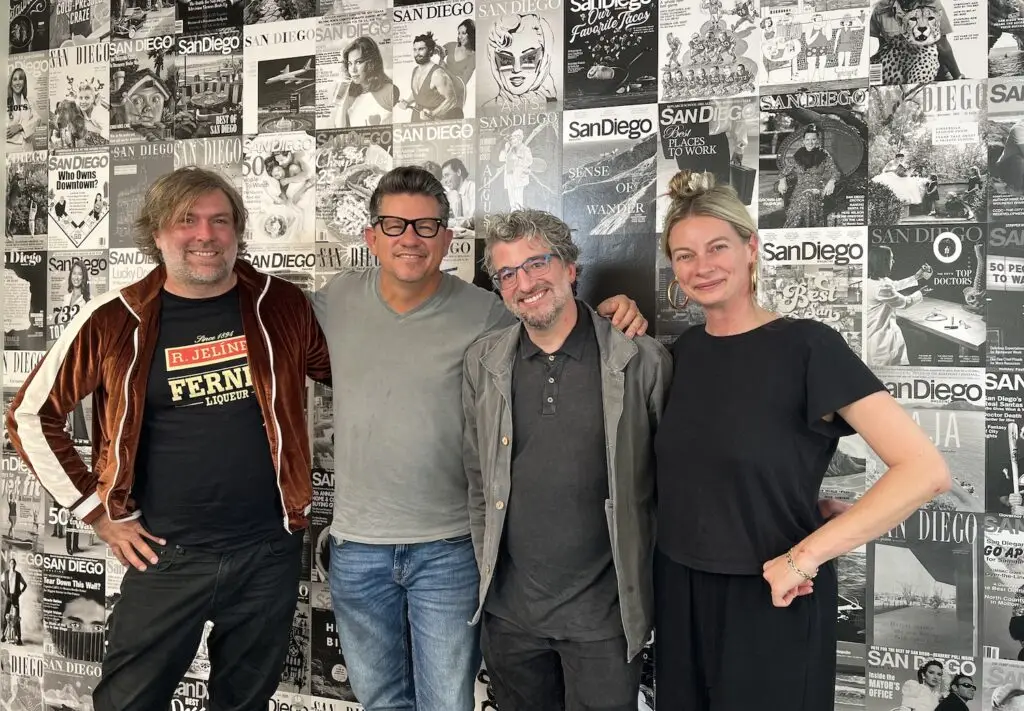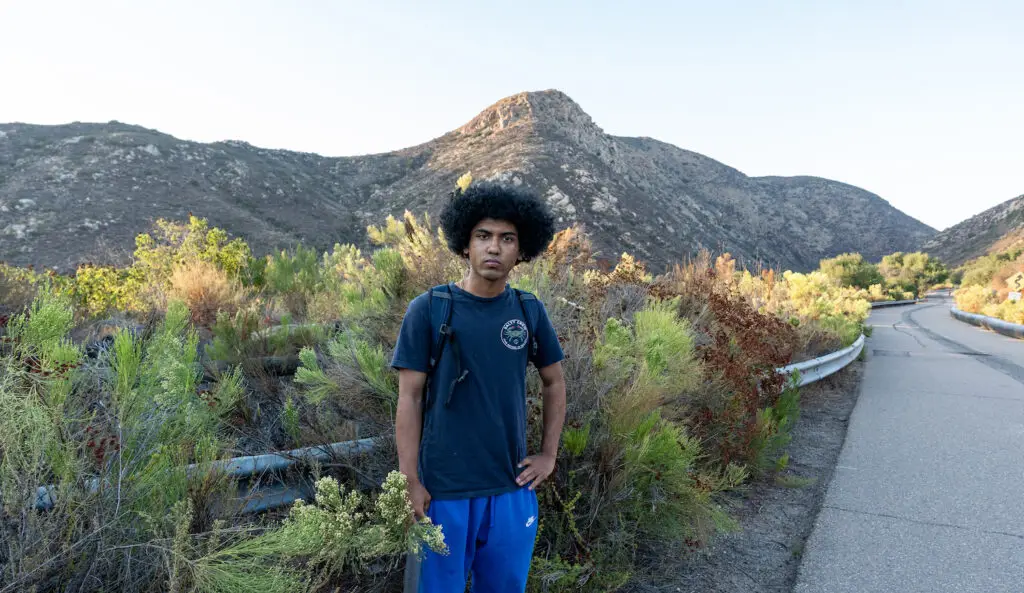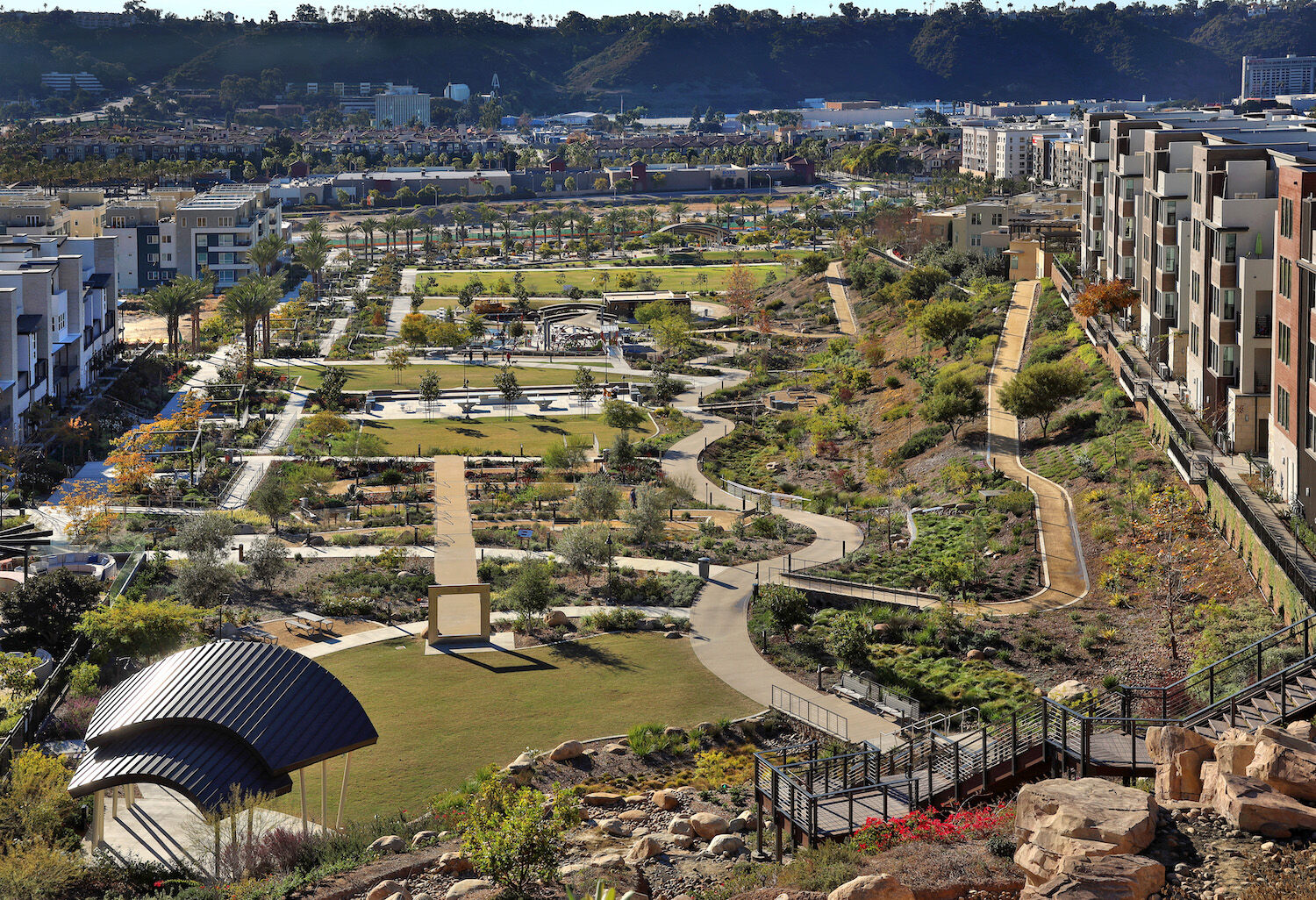
Civita Park
Courtesy of Sudberry Properties
Like many young professionals, I lived in San Diego’s Mission Valley in my early 20s. For someone my age and income in the late 1990s, it was either there or Pacific Beach, where the raucous nightlife made the neighborhood stink of beer, puke, and Lysol.
By contrast, Mission Valley was just the right kind of boring. We had a one-bedroom, 700-square-foot apartment with a balcony in a stucco megacomplex near what was then Qualcomm Stadium. On game nights, we could watch the fireworks from the parking lot. It was easy walking distance to a convenience store, a bar, or Mexican food, close to the trolley, and hemmed in by easy-access freeways to our day jobs. We didn’t try to meet our neighbors. We weren’t looking for art, culture, or community. It was a way station along the route of San Diego living. It was a functional place, once full of dairy farms and gravel quarries.
But everyone has to grow up someday. And perhaps Mission Valley is experiencing its own coming of age. Under construction throughout its 2,400 acres are an array of residential, retail, and commercial projects that could make the area more of an entity. Bulldozers and graders are prepping the foundation for a new, multi-billion-dollar kind of valley—a walkable, bikeable, riverside utopia. That is, if the renderings pan out.
Signs of Maturity
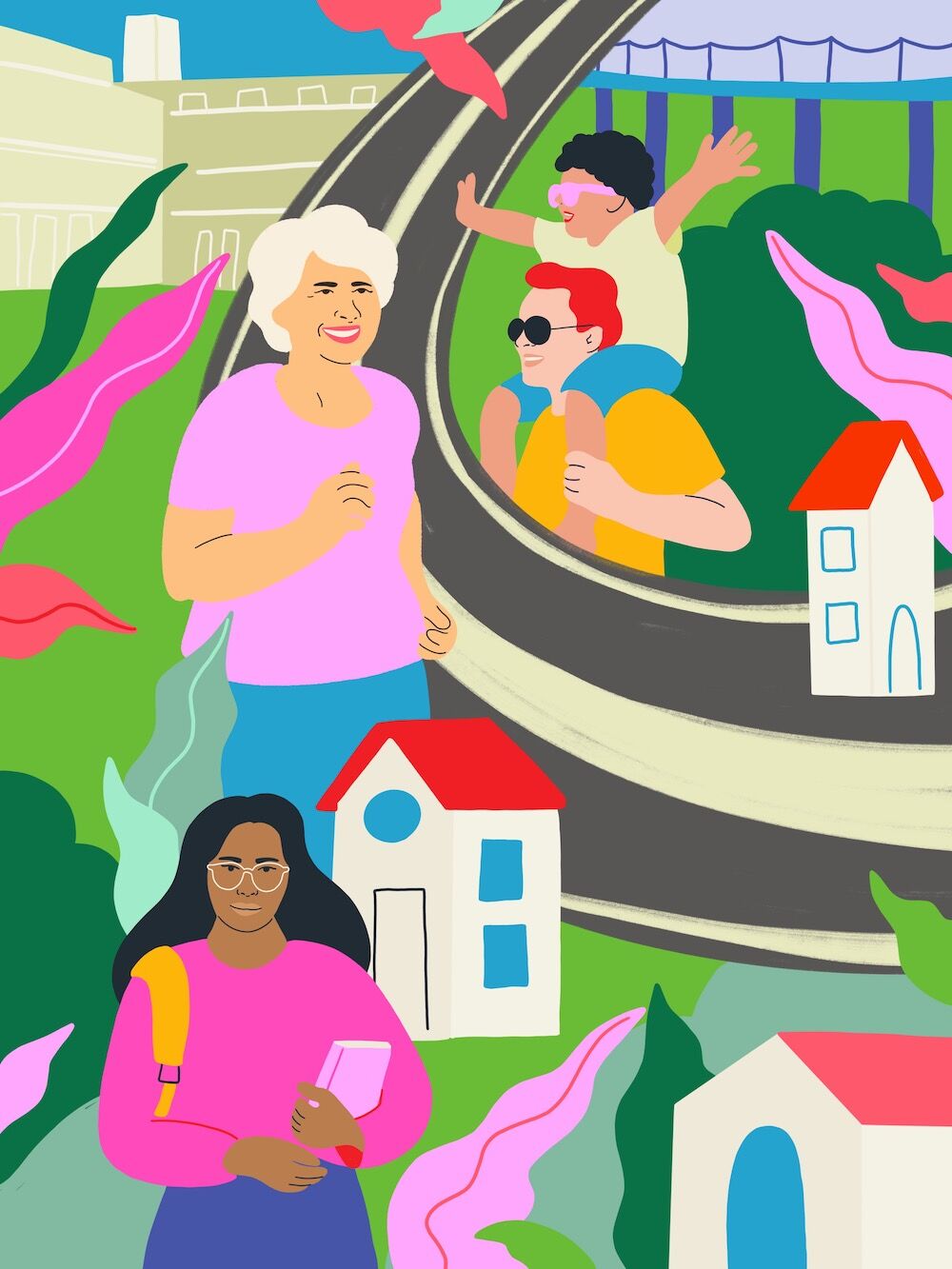
Mission Valley – illustration 2
Illustration by Sol Cotti
At the geographic midpoint of San Diego, Mission Valley has long been at the center of urban development. When highway improvements began to crisscross the floodplain of the San Diego River in the 1950s, shopping malls, big-box retailers, hotels, and car dealerships all staked their claim.
Now it’s peppered with multifamily housing. The neighborhood is projected to grow from 11,200 to 39,200 housing units by 2050 under a community plan last updated in 2019. For perspective, that’s 580 units a year, in a valley about six miles across east to west, two miles north to south. Its boundaries are generally considered to be Friars Road on the north, San Diego River to the east, the slopes of the valley on the south, and I-5 on the west.
As plans go, the idea is to build more medium- and high-density housing that seamlessly mixes with trendy stores, restaurants, and office buildings while being more pedestrian friendly and close to public transit. You’ve heard it before—a village concept where people can “live, work, and play.”
Where the San Diego River slices through on its way to the ocean, city planners hope to scrub its reputation for accumulating trash and floodwaters to instead serve as a welcoming nature preserve for active and passive recreation. Some of those river improvements are being made in cooperation with the developers erecting billion-dollar master-planned communities along the river’s edge. In turn, the new communities could help chip away at San Diego’s everlasting housing needs.
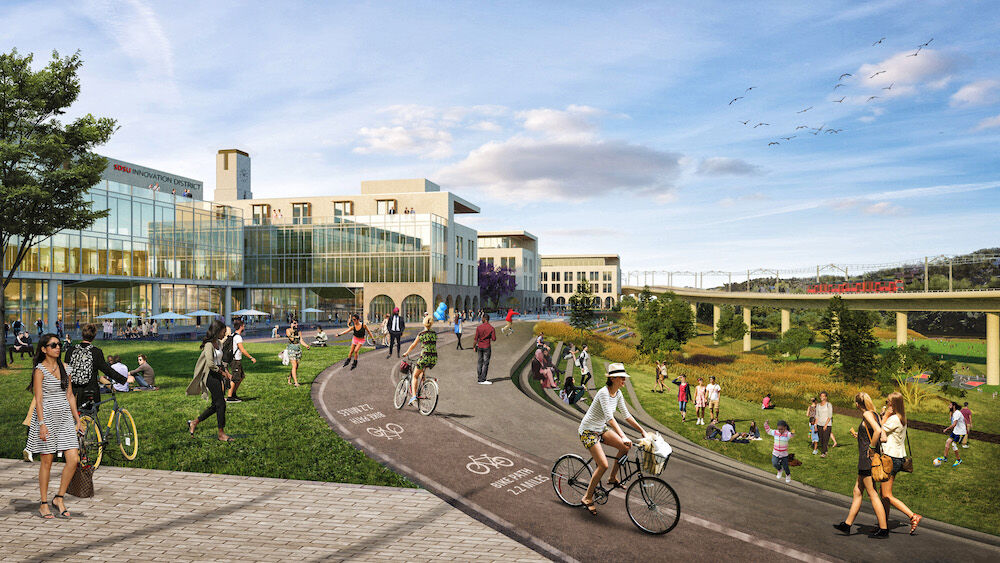
SDSU River Park Hike and Bike Trail
Courtesy of Carrier Johnson
“I would say the perfect word to describe Mission Valley is ‘growth.’ We have thousands more units coming online in the next five years,” says Raul Campillo, the city councilmember representing district 7, which includes Mission Valley.
“Tourism, sports, and nature—those are the sort of cohesive community building blocks that we’re going to see out of Mission Valley.”
What’s Going Up
Among the largest new residential projects is Civita, 230 acres off Friars and Mission Center roads that was formerly a sand and gravel quarry. The development has been carving its way down the slopes of Mission Valley since 2010 and will ultimately include 4,780 housing units, but it’s still years from completion.
Colton Sudberry, CEO and president of Sudberry Properties, Civita’s master developer, says the project is “maturing into the energetic urban village that we envisioned when we partnered with the Grant family, which owned the property since the early 1900s.” Over 2,700 residences in the community have already become available to buy or rent. Another 337 will follow this year, and construction will begin on The Row at Civita, a mixed-use shopping center with stores, restaurants, and a hotel
Then there’s Riverwalk San Diego off Friars and Fashion Valley roads, where the existing golf course will be turned into 4,300 homes on 200 acres. The first phase of construction is set to begin in April 2022, and the course will continue operation with fewer holes for the next five years or so.
You’d be forgiven if you couldn’t tell the difference between some of the many new smaller apartment complexes on your drive to the mall. They’re packed close to one another and similarly modern in architectural design and color schemes. Visible from westbound I-8, The Townsend is finishing up 267 apartments where the Witt Lincoln car dealership used to be; leasing could begin this spring. It’s next door to Metro Mission Valley, completed in 2018 as Millennium Mission Valley, which brought the neighborhood 291 apartments where Bob Baker Ford used to be. Across Camino de la Reina from the former San Diego Union-Tribune building, the new Alexan Gallerie apartment complex brings 284 apartments to the block.
The mix of compact housing types entering the marketplace—from million-dollar detached homes to modest apartments—could attract a diverse array of students, families, and seniors, according to Campillo. San Diego’s Inclusionary Affordable Housing Ordinance requires all new residential and mixed-use developments set aside at least 10 percent of their rental units as affordable (as defined by U.S. Department of Housing and Urban Development benchmarks related to the county’s median income). For instance, apartments in Civita’s newer Siena senior complex start at $468 a month.
“I think we’re going to see an increase in all demographics over the next ten years as Mission Valley is developed,” Campillo says. “It’s centralized, so I imagine we’re going to see a lot of different folks looking here.”
Making the Grade
The biggest and most anticipated project breaking ground here is SDSU Mission Valley, on the 166-acre site of the former stadium and its parking lot. The multiphase project will include a 1.6 million-square-foot research and innovation district, a $310 million sports venue big enough for a crowd of 35,000, and more than 4,600 residential units on regraded land alongside the San Diego River. It could take 10 to 15 years and $3.5 billion, and would prove a striking new facet of Mission Valley’s character.
“This is obviously a major change from what the site used to be,” says Gina Jacobs, the development’s associate vice president. The land has living memory as a sports venue, but before that it was a dairy farm, part of the Spanish mission, and ancestral home of the Kumeyaay people. “Mission Valley is growing in a way that maybe hasn’t been envisioned before. We’re really trying to create something unique where all the pieces work together and to the benefit of the greater region.”
The first completed piece of the project will be Snapdragon Stadium, set to open September 3 with the San Diego State Aztecs football season-opener against the University of Arizona Wildcats.
Even the Snapdragon name is a nod toward modernization. San Diego–based tech giant Qualcomm held the naming rights for the previous stadium from 1997 to 2017. Qualcomm now has a 15-year, $45 million deal to name the new stadium after its mobile platform brand Snapdragon, used for smartphones, gaming devices, and virtual reality headsets.
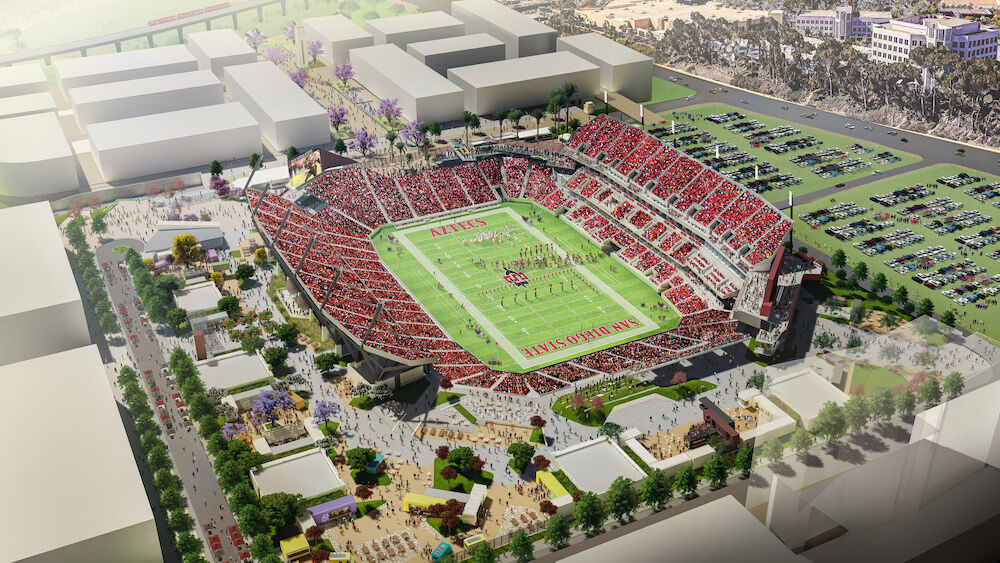
Snapdragon Stadium
Courtesy of Gensler
Snapdragon Stadium is designed to accommodate college and high school sports, international soccer matches, concerts, and festivals; and it’s being built with energy-efficient and eco-conscious principles in mind, aiming for potential LEED Gold certification.
To divert waste from the landfill, construction is reusing as much of the old stadium as possible. Jacobs walked me through a bird’s-eye view of the site in a recent Zoom call. Pointing to a pile of gray debris, she said, “That is actually the old stadium crushed up into aggregate that we’re going to be using as road base, fill, and other hardscape aspects on the site. We recycled probably 90 percent of the old stadium in total.”
The concrete will live on as the foundation for picnic tables or flagstone-style pathways. Some of the old steel and rebar will be reused or recycled. The 16-foot bronze statue of San Diego Union sportswriter Jack Murphy and his dog Abe will be brought back, too. Signage throughout the SDSU Mission Valley project will recognize some of the culturally significant aspects of the land, Jacobs says. “We’re trying to recognize the past but bring it into the future.”
The Denizens
Some 26 years ago, Ian Linekin and his business partners knew Mission Valley was primed for growth.
“This is our first and only location,” says Linekin, managing partner for McGregor’s Bar & Grill. “We picked this location because it was—and is going to be—a third of a mile from a major venue.”
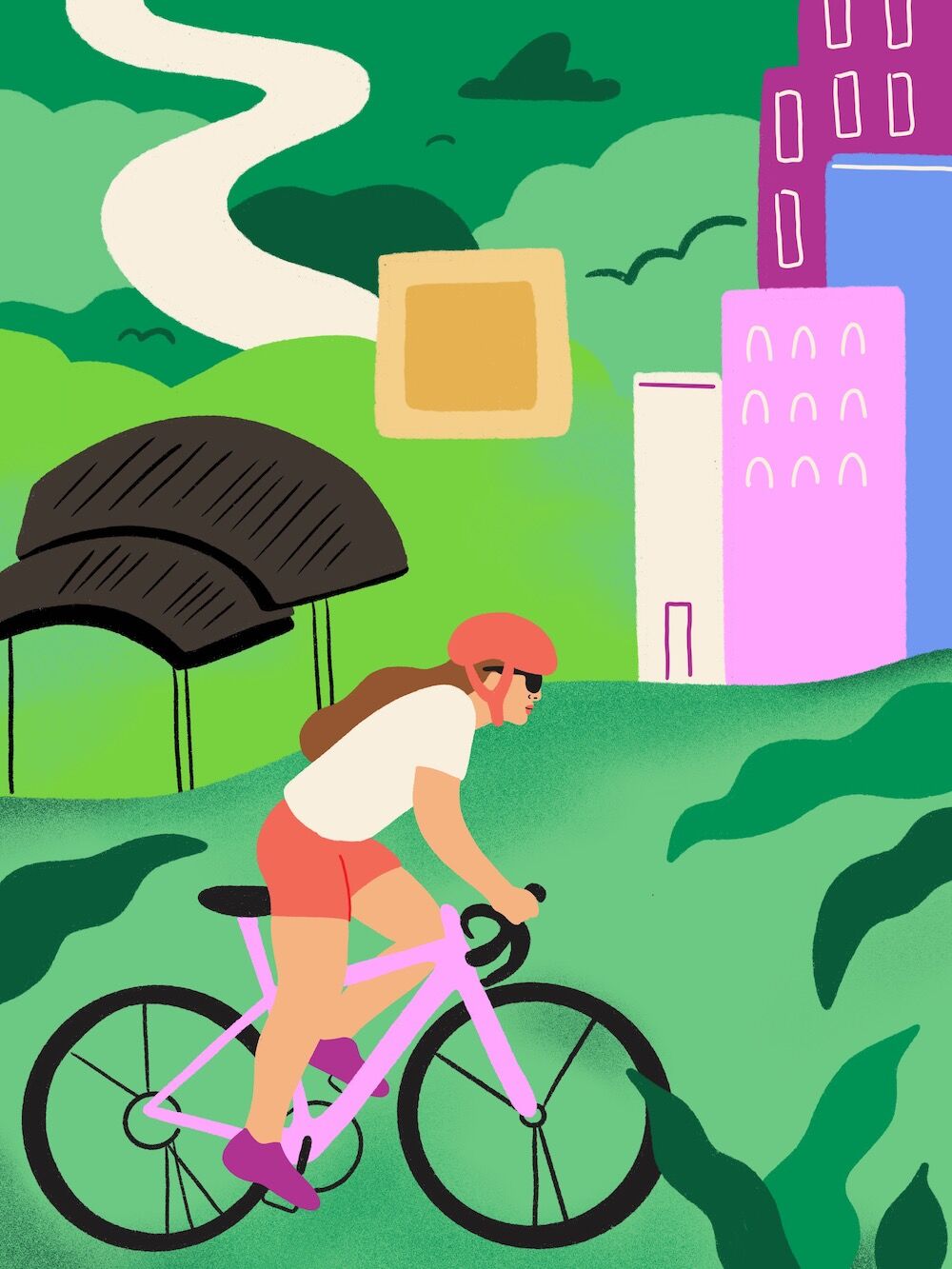
Mission Valley – illustration 1 – bike
Illustration by Sol Cotti
Linekin grew up in San Diego, and remembers when Mission Valley was a dairy farm he could see from I-8. When McGregor’s first opened in the 1990s, there weren’t as many condominiums, so there were fewer residents and less traffic.
“The neighborhood was less populated, and there was definitely less competition,” Linekin said. “And the Padres were down the street.”
MacGregor’s, which is in a shopping center on Mission Road just over I-15 from the SDSU project, is a popular hangout for neighborhood residents, local office workers—and these days, construction workers from nearby work sites. People come in for a burger and a beer, play darts and pool, and watch games on about 30 TVs inside and outside the 6,000-square-foot bar.
When the Padres moved downtown and the Chargers defected for Los Angeles, many thought McGregor’s would suffer. However, given that the handful of home games would draw customers in for a drink just an hour before or after, Linekin says the impact was minimal.
“If anything, we got busier,” he says. “If you base your business on just when there are games, you’ve got a bad business model.”
The new stadium should bring a fresh mix of sports fans to McGregor’s. From Linekin’s perspective, any new bars or restaurants within the scope of SDSU Mission Valley are welcome additions to the neighborhood.
“We’re stoked. It’s fantastic,” he says. “Competition is good. It keeps you on your feet.”
Down by the River
Redevelopment in the Mission Valley area means losing its golf course, but city planners hope to trade Riverwalk’s manicured greens for improvements along the biodiverse San Diego River. It runs 52 miles through the county from its headwaters near Julian, but its flow hasn’t always harmonized with Mission Valley’s urban development.
Developers are incorporating the river and the natural environment around it into their projects as key selling points. Riverwalk San Diego is set to include 97 acres of primarily passive-use open space—in other words, parks. Natural open areas for play, picnics, and bird-watching. SDSU Mission Valley will have 80 acres of community parks and open space.
And the projects are required to account for flooding. Riverwalk’s plans include improvements to Fashion Valley Road to reduce flooding, which happens just about every winter. SDSU Mission Valley’s grading plan and storm drains are designed to collect rainwater in filtration basins rather than letting it run across concrete and into the river untreated. “We’re really building the environment to help create a more natural space to support flooding if and when it occurs,” Jacobs says.
Environmental groups, government agencies, homelessness task forces, and residents have been collaborating to preserve and protect the San Diego River since at least 2001, when the San Diego River Park Foundation formed in response to a massive sewage spill into the river.
The larger, long-term regional plan envisions a San Diego River Park trail for hiking and biking from the mountains to the beach, with artwork, benches, and educational elements along the way. Councilmember Campillo serves on the state’s San Diego River Conservancy governing board and is chair of the Mission Trails Regional Park Task Force. He says big improvements along the river will take a decade or more.

Mission Valley – illustration 3
Illustration by Sol Cotti
In the meantime, San Diegans can look forward to construction beginning in the next year or two on a river education center on 17 acres at Qualcomm Way and Camino del Rio North. The first phase of the $4.8 million concept will include an outdoor stage with seating for 100 students, a butterfly garden, and hands-on interpretive elements.
PARTNER CONTENT
“The idea is to have kids out there in nature near the river; they can use microscopes to look at different organisms and plant species from the area,” Campillo explains. “We are protecting the environment and providing Mission Valley residents—and all of San Diego—with exciting, nature-based walking paths and preserving the plant species, animal species, and water quality for all of San Diego.”




